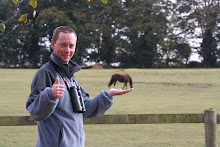Its not very often that you see 4 grey phalaropes in just two days but after seeing two at Blakeney at the weekend, one turned up on the tidal pool yesterday afternoon. The bird (183)showed very well at the end of the day and at times was disappearing under the vegetation alongside the path.


The small white dot is the bird and here it is a bit closer!
With news coming in all last night, it looked like there was a decent fall occurring along the coast. With that in mind I decided to get onto the reserve early and check out some of the more inaccessible bushes. Although there wasn't lots of birds around the variety was good. Several chiffs were moving around the bushes and an immature male redstart popped out briefly. 'Pishing' bought out a couple of lesser whitethroats but my attention was grabbed by something else. Getting my bins onto the bird produced a corking yellow browed warbler (184) - well worth the early start!
With the prospect of more birds dropping in, I decided to take half day toil and head back out to the same bushes. Things looked good with a spotted fly 'new in' around the carpark and upto 5 wheatear on the beach. Some of the birds from the morning were still around but a willow warbler, garden warbler and chiffchaff were new. At times it seemed that thrushes and robins were dropping out of the sky and with them were 2 brambling, 5 snow and 7 Lapland buntings.
As I was watching the bushes a warbler flicked into view. Although the views were brief, it has a very yellow face and breast and very white underparts. I called to Richard that I had a possible wood warbler (185)t had flown into the bracken. The bird was very elusive feeding with a chiff but after about an hour we were able to get good enough views the confirm the ID. Only my 2nd reserve record and my 1st ever autumn record.
On the way back the grey phal was still performing well but amazingly another, more distant, bird had been found on the fresh marsh. 4 in 2 days, 2 in 10mins - can't be bad!!


